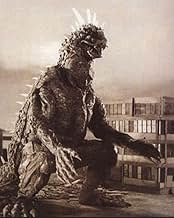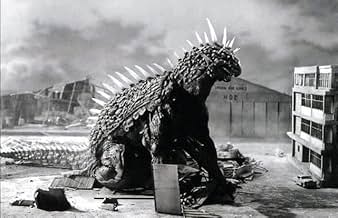Añade un argumento en tu idiomaOriginal Japanese version. Research in the Tohoku region comes across a monster known to the locals as the mountain god Baradagi.Original Japanese version. Research in the Tohoku region comes across a monster known to the locals as the mountain god Baradagi.Original Japanese version. Research in the Tohoku region comes across a monster known to the locals as the mountain god Baradagi.
Reseña destacada
Of all the kaijyu movies Toho has produced in the '50s, this probably is the least well known. It was originally available in United States in a super 8 format under the title "Varan the Unbelievable", and sported American actors. The one reviewed here is not this Americanized version but the original Japanese version called "Daikaijyu Baran" (Literal translation: Giant monster Baran). Being a kaijyu eiga fan, I used to hear about this monster a lot and wished I could find a copy for a long time. I'm happy that it is now available on DVD.
Baran gets its inspiration from Japanese flying squirrel called musasabi and it was intended to be a flying monster from the start. What makes this movie little weak is the lack of character of the monster itself. In most Japanese kaijyu movie, there's a subplot that justifies the character of the monster, but in this movie this is lacking. He's supposed to be some sort of god to the village people, but when he shows up, he's just a giant reptile out for destruction.
This is a cult classic kaijyu movie, and definitely worth a watch before it disappears into obscurity again.
Baran gets its inspiration from Japanese flying squirrel called musasabi and it was intended to be a flying monster from the start. What makes this movie little weak is the lack of character of the monster itself. In most Japanese kaijyu movie, there's a subplot that justifies the character of the monster, but in this movie this is lacking. He's supposed to be some sort of god to the village people, but when he shows up, he's just a giant reptile out for destruction.
This is a cult classic kaijyu movie, and definitely worth a watch before it disappears into obscurity again.
- ebiros2
- 23 oct 2005
- Enlace permanente
Argumento
¿Sabías que...?
- CuriosidadesThis film began as a direct-to-television co-production between AB-PT and Toho, and thus was shot in black and white in the Academy aspect ratio. AB-PT went bankrupt during production, but a two-part TV film was still completed. The two parts were then edited into a single, longer feature film to be shown in Japanese theaters, which involved extending and re-recording the musical score, shortening scenes and adding new ones. This theatrical feature was then cropped shot by shot and released in an ersatz anamorphic widescreen format apparently adapted from SuperScope called TohoPanScope. Neither the TV version nor the theatrical version of this film exist in the Academy ratio, but the fully mixed audio track for the TV version still exists as of this date.
- PifiasSeveral short clips of Varan's attack on Tokyo are actually stock footage from Japón bajo el terror del monstruo (1954), including a shot of Godzilla's tail smashing into a building and a POV shot from inside a warehouse of Godzilla's foot caving the structure in. Similarly, Varan's roar is an amalgamation of various Toho giant monster roars, including that of Godzilla himself.
- Versiones alternativasThe scene of Baran (aka Varan) flying is deleted from the American version of the film.
- ConexionesEdited into Varan the Unbelievable (1962)
Selecciones populares
Inicia sesión para calificar y añadir a tu lista para recibir recomendaciones personalizadas
- How long is Varan?Con tecnología de Alexa
Detalles
- Duración1 hora 27 minutos
- Color
- Mezcla de sonido
- Relación de aspecto
- 2.00 : 1
Contribuir a esta página
Sugerir un cambio o añadir el contenido que falta

Principal laguna de datos
By what name was Daikaijû Baran (1958) officially released in Canada in English?
Responde

























